A 51,200-year-old cave painting has been discovered on an Indonesian island, making it the oldest evidence of storytelling in art ever found.
The discovery took place on the island of Sulawesi, in a limestone cave called Leang Karampuang. Inside the cave, researchers came across a mysterious painting depicting an unprecedented scene. The artwork features “three human-like figures interacting with a wild pig.”
The painting was spotted by researchers from Australia’s Griffith University, Indonesia’s National Research and Innovation Agency (BRIN) and Southern Cross University.
“Humans have probably been telling stories for much longer than 51,200 years, but because words don’t fossilize, we can only rely on indirect approximations like depictions of scenes in art – and the art from Sulawesi is now by far the oldest evidence of this type known to archaeology,” said Adhi Agus Oktaviana, an Indonesian rock art expert at BRIN.
Using a new dating technique
For years, Europe held the record for the oldest known cave paintings. But this new artwork has shattered that record.
How were they able to determine such an ancient age? The answer lies in a cutting-edge technique called laser ablation U-series (LA-U-series) analysis. This procedure studies the microscopic layers of calcium carbonate that build up on the artwork, revealing a precise minimum age.
The results indicated that the underlying artwork was created at least 51,200 years ago by early humans, making it the oldest narrative art discovered in the world.
“We have already used the uranium series method to date very ancient rock art in two regions of Indonesia, Sulawesi and Borneo, but our new LA-U series technique is more precise, allowing us to date the first layers of calcium carbonate formed on the work and to get closer to the time when the work was created. It will revolutionize the dating of rock art,” explains Professor Maxime Aubert, co-developer of this technique and specialist in archaeological sciences at the GCSCR.
This new technique promises a leap forward in the dating of rock art. Archaeologists will be able to distinguish natural alterations and obtain more reliable age determinations.
The artistic skills of ancient men
Surprisingly, none of the famous European Ice Age artworks are as old as this latest discovery, with the exception of some controversial finds in Spain.
“This is the first time that rock art in Indonesia has been traced back more than 50,000 years,” Oktaviana said. This Indonesian artwork demonstrates that storytelling was most likely a key element of early human creative expression.
According to the press release, the team also revisited another cave site in Sulawesi, Leang Bulu’ Sipong 4. Using the new technique from the LA-U series, they were able to refine the age of a previously dated scene depicting therianthropes (half-human, half-animal beings) hunting animals. This brought the minimum age of the artwork to about 48,000 years, compared to at least 44,000 years in previous estimates.
The rock paintings of Sulawesi offer a captivating glimpse into the lives of our distant relatives, suggesting that they possessed artistic abilities and used them to communicate stories, thoughts and experiences.
The results were published in the journal Nature.
ABOUT THE PUBLISHER
Mrigakshi Dixit Mrigakshi is a science journalist who enjoys writing about space exploration, biology, and technological innovations. Her professional experience spans both broadcast and digital media, which has allowed her to learn a variety of storytelling formats. Her work has been featured in renowned publications including Nature India, Supercluster, and Astronomy magazine. If you have any ideas in mind, feel free to drop her an email.


